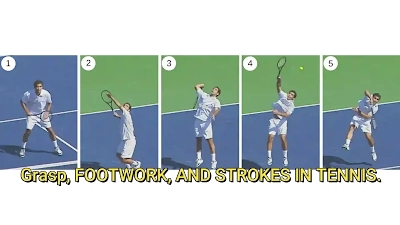 |
| Grasp, FOOTWORK, AND STROKES IN TENNIS. |
Grasp, FOOTWORK, AND STROKES IN TENNIS.
Footwork is weight control. It is the right body position for strokes, and out, all things considered, strokes ought to develop. In clarifying the different types of stroke and footwork I am composing as a right-hand player. Left-handers should essentially switch the feet.
Racquet grasp is an exceptionally fundamental piece of stroke because a flawed hold will destroy the best serving. It is a characteristic hold for a top forehand drive. It is innately feeble for the strike, as the main normal shot is a cleave stroke.
To secure the forehand grasp, hold the racquet with the edge of the edge towards the ground and the face opposite, the handle towards the body, and "shake hands" with it, similarly as though you were welcoming a companion. The handle settled serenely and normally into the hand, the line of the arm, hand, and racquet are one. The swing brings the racquet head on a line with the arm, and the entire racquet is just an augmentation of it.
The strike grasp is a quarter circle turn of hand on the handle, welcoming the hand on top of the handle and the knuckles straightforwardly up. The shot goes ACROSS the wrist.
This is the best reason for a grasp. I don't advocate learning this grasp precisely, however, model your normal hold as intently as conceivable on these lines without forfeiting your own solace or distinction.
Having once settled the racquet in the hand, the following inquiry is the place of the body and the request for creating strokes.
All tennis strokes, ought to be made with the body' at right points to the net, with the shoulders arranged corresponding to the line of the trip of the ball. The weight ought to consistently go ahead. It should pass from the back foot to the front foot right now of striking the ball. Never permit the load to be disappearing from the stroke. It is the weight that decides the "pace" of a stroke; swing that, chooses the "speed."
Allow me to clarify the meanings of "speed" and "speed." "Speed" is the real rate at which a ball goes through the air. "Pace" is the energy with which it falls off the ground. The pace is weight. It is the "sting" the ball steals when it leaves away from the ground, providing the unpracticed or clueless player with a shock of power which the stroke, not the slightest bit showed.
A large number of players have both "speed" and "speed." Some shots might convey both.
The request for learning strokes ought to be:
1. The Drive. Front and strike. This is the establishment of all tennis, for you can't develop a net assault except if you have the groundstroke to open the way. Nor would you be able to meet a net assault effectively except if you can drive, as that is the main fruitful passing shot.
2. The Service.
3. The Volley and Overhead Smash.
4. The Chop or Half Volley and other coincidental and fancy strokes.


Comments
Post a Comment